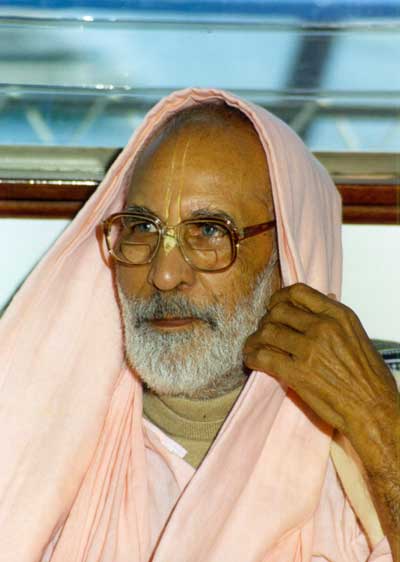

[From 1990 to 1995, a group of ten to twelve ISKCON GBC sannyasis and other senior ISKCON members used to regularly visit Srila Bhaktivedanta Narayana Gosvami Maharaja in his Vrndavana and Mathura temples, and sometimes in his quarters at the ISKCON Juhu Beach Temple. At those times they would inquire from him about the deep meanings in various Gaudiya-Vaisnava scriptures, such as Jaiva-dharma, Raga-vartma-candrika, the Rasa-pancadhyayi chapters of Srimad-Bhagavatam, and Sri Vilapa-kusumanjali. There were a few hundred such meetings, and the audio sound files of many of these meetings can be found on www.purebhakti.tv.
The following is Part 1 of one of these meetings, which took place on March 29, 1993.
[Part 2 is posted here. Part 3 is posted here.]
nitya-bandhakrsna haite nitya-bahirmukha[Question:] The jiva in this world he is called eternally conditioned?
nitya-samsara, bhunje narakadi duhkha[Apart from the ever-liberated devotees, there are the conditioned souls, who always turn away from the service of the Lord. They are perpetually conditioned in this material world and are subjected to the material tribulations brought about by different bodily forms in hellish conditions.
(Sri Caitanya-caritamrta, Madhya-lila, 22.13)]
[Srila Narayana Gosvami Maharaja:] No, he is not an eternally conditioned soul. In this verse, nitya, eternal, actually means anadi, or beginningless, meaning that he has been conditioned since time immemorial. If it meant eternal in the true sense, we would have no scope to get out of maya.
[Question:] The anadi-baddha jiva never had any direct relationship with Krsna?
[Srila Narayana Gosvami Maharaja:] It cannot be said exactly like this. Everything about his relationship with Krsna is present in his svarupa, but he has never felt it. In cannot be said that in a seed there is no tree, no fruit, no branches, and no leaves. All this is there, but we cannot see it; it is in a latent position.
If a person has eyes, he sees everything in the seed how many leaves will come, how many fruits will be there, when the leaves will be green, after how much time the leaves will turn yellow, at what time they will fall, and when there will again be new leaves. Everything is there in the seed, in a latent stage.
The mukta-mahapurusa, or liberated, self-realized soul, sees that the soul in this world is serving Krsna, but we see that we are conditioned souls. No definitive mundane words can be used to actually explain jiva-tattva, because it is beyond siddhanta. In other words, the form of the soul is beyond our comprehension.
[Question:] Now the next point
[Srila Narayana Gosvami Maharaja:] Do you understand this point?
[Question:] Not completely, because we can say that a seed was never a tree, even though it is latent. It is not a tree, but it will become a tree. Isnt it the same thing with our relationship with Krsna? You can say that the seed of our relationship is there, but it doesnt mean there is an active relationship.
[Srila Narayana Gosvami Maharaja:] It is not that everything can be compared in every respect, so there are only some similarities in this analogy. Not everything is similar. For example, the seed of a tree is not cetana (conscious, or alive), but atma, the soul, is cetana. Maya is not present in the atma. There are no clouds in the sun; but they are outside of the sun. We see the clouds, but those who are above the clouds are always seeing the sun; they do not see clouds. Similarly, self-realized souls like Sri Narada Rsi can see that we are always serving, even though we are conditioned souls.
What we tell at this stage is only for some time. It is only an example for you at this time. It is not an exact example. You should try to perform harinama, and beg for mercy so that you will come out of maya and realize all of these truths. Harinama is pure:
nama cintamanih krsnasWho can realize this? A devotee who has come to the stage of nirdhuta-kasaya or bhagavat-parsada-deha-prapta *[See endnote 1] realizes that there is actually no maya; but for a baddha-jiva, a conditioned soul, there is no conception of mukta, liberation. Those who have the bodies of Krsnas associates can realize this. Conditioned souls can only suppose what reality is like.
caitanya-rasa-vigrahah
purnah suddho nitya-mukto
bhinnatvan nama-naminoh[The holy name of Krsna is transcendentally blissful. It bestows all spiritual benedictions, for it is Krsna Himself, the reservoir of all pleasure. Krsnas name is complete, and it is the form of all transcendental mellows. It is not a material name under any condition, and it is no less powerful than Krsna Himself. Since Krsnas name is not contaminated by the material qualities, there is no question of its being involved with maya. Krsnas name is always liberated and spiritual; it is never conditioned by the laws of material nature. This is because the name of Krsna and Krsna Himself are identical.
(Padma Purana)]
Srila Bhaktivinoda Thakura has written in his Jaiva-dharma that devotees who perform harinama and beg mercy from Sri Krsna and Sri Caitanya Mahaprabhu may realize transcendence (cetana-vastu, cid-vastu) [Krsna is the complete cid-vastu, or living being, and the jiva is the infinitesimal cid-vastu, or spirit spark], otherwise it is not possible.
In sastra, numerous siddhantas (philosophical conclusions) have been told, only for us. It is not that all siddhanta is for all persons at all stages of their development in bhakti. There is some siddhanta for kanistha-Vaisnavas (neophytes in bhakti), some for madhyama-Vaisnavas (those devotees in the intermediate stage), and some for uttama-Vaisnavas, those devotees who have crossed over maya. It is not that all siddhanta is in the same category. In Srimad-Bhagavatam, so many categories of siddhanta are given for various classes of persons. We should therefore try to do bhajana and realize all these transcendental or spiritual truths (cinmaya-tattva). Mundane logic and reasoning will not go there at all.
Chant, Hare Krsna Hare Krsna Krsna Krsna Hare Hare, Hare Rama Hare Rama Rama Rama Hare Hare, and beg pardon. Perhaps what you previously thought about the jiva and bhakti has changed. Perhaps you are now thinking, understanding, and realizing differently. Similarly, your present understanding will also change when you will become a maha-bhagavata and cross over maya. Then you will realize everything.
An important point to note: the idea that the anadi-baddha jiva, the conditioned soul in this world, has fallen from the spiritual abode of the Lord is not accepted by our acaryas.
What is your question?
[Question:] When Srila Jiva Gosvami says that by association one gets bhakti, or by mercy one gets bhakti...
[Srila Narayana Gosvami Maharaja:] By the association of what kind of devotee? A kanistha-vaisnava? A madhyama-vaisnava?
A madhyama-adhikari Vaisnava can only give siddhanta. He cannot speak from experience. If we want realization, it is necessary to hear from the three kinds of uttama-bhagavatas: Nirdhuta-kasaya, murchitta-kasaya and bhagavat-parsada-deha-prapta. The most elevated of the three is bhagavat-parsada-deha-prapta. Second, nirdhuta-kasaya, like Srila Sukadeva Gosvami, and third, murchitta-kasaya, like Sri Narada Muni. When Narada Muni was a practicing devotee he was a murchitta-kasaya. Then, after having received darsana of the Lord, traveling here and there and always chanting the sankirtana of Krsnas holy names, he became a first class uttama-bhagavata; he attained the body of an associate of the Lord. Anyone can have bhakti by the association of these three maha-bhagavatas. The association of a madhyama-adhikari can take us to the entrance of sadhana-bhakti, and his mercy can lead us to an uttama-bhagavata.
[*Endnote 1: Siddha-mahapurusas are of three types: (1) bhagavat-parsada-deha-prapta (those who have obtained perfected spiritual bodies as eternal associates of the Lord), (2) nirdhuta-kasaya (those who have thrown off all material impurities) and (3) murcchita-kasaya (those in whom a trace of material contamination still lies dormant).
(1) Bhagavat-parsada-deha-prapta
After giving up the gross material body, those who have perfected themselves through the practice of bhakti obtain sac-cid-ananda spiritual forms, which are just suitable for the service of the Lord as associates (parsadas). Such persons are the best of all uttama-bhagavatas.
(2) Nirdhuta-kasaya
Those who, although still residing within the gross material body made of five elements, have no trace of material desire (vasana) nor any material impressions (samskaras) within their hearts are called nirdhuta-kasaya (those who have thrown off all material impurities). They belong to the intermediate class of uttama-bhagavatas.
(3) Murcchita-kasaya
Those siddha-mahapurusas pursuing the path of bhakti in whose hearts there remains a trace of desire (vasana) and impressions (samskaras) based on the material mode of goodness are known as murcchita-kasaya. Due to influence of their bhakti-yoga, these desires and impressions remain in a dormant or unconscious state. As soon as there is a favourable opportunity, their worshipful object, Sri Bhagavan, somehow causes their desire to be consumed and attracts them to His lotus feet. Such elevated souls belong to the preliminary stage (kanistha) of uttama-bhagavatas.
Devarsi Narada is an example of the topmost uttama-bhagavata. Sukadeva Gosvami belongs to the intermediate stage of uttama-bhagavatas (nirdhuta-kasaya). Sri Narada in his previous birth as the son of a maidservant is an example of the preliminary stage of uttama-bhagavatas (murcchita-kasaya).
The association and mercy of these three kinds of maha-bhagavatas is the cause of the manifestation of sraddha. (Sri Bhakti-rasamrta-sindhu)]
Editorial advisors: Pujyapad Madhava Maharaja and Sripad Brajanath dasa
Transcriber and typist: Vasanti dasi
Editor: Syamarani dasi
Proof-reader: Krsna-kamini dasi
HTML: Bhutabhavana dasa
![[BVML Home Page]](../../grfx/bml_logo.gif)
